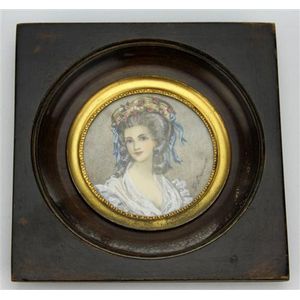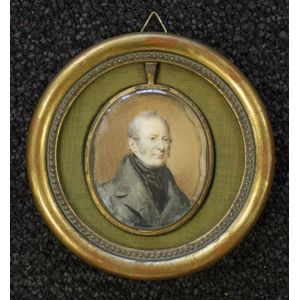English Gentleman Portrait Miniature, 1840
You must be a subscriber, and be logged in to view price and dealer details.
Subscribe Now to view actual auction price for this item
When you subscribe, you have the option of setting the currency in which to display prices to $Au, $US, $NZ or Stg.
- Ivory - Ivory is a hard white material that comes from the tusks of elephants, mammoth, walrus and boar, or from the teeth of hippopotamus and whales. The ivory from the African elephant is the most prized source of ivory. Although the mammoth is extinct, tusks are still being unearthed in Russia and offered for sale.
Ivory has been used since the earliest times as a material for sculpture of small items, both in Europe and the east, principally China and Japan.
In Asia ivory has been carved for netsuke, seals, okimono, card cases, fan supports, animals and other figures and even as carved tusks.
In the last 200 years in Europe ivory has been used to carve figures, for elaborate tankards, snuff boxes, cane handles, embroidery and sewing accessories, in jewellery and as inlay on furniture. Its more practical uses include being used for billiard balls, buttons, and a veneers on the top of piano keys.
The use and trade of elephant ivory have become controversial because they have contributed to Due to the decline in elephant populations because of the trade in ivory, the Asian elephant was placed on Appendix One of the Convention on International Trade in Endangered Species (CITES), in 1975, and in January 1990, the African elephant was similarly listed. Under Appendix One, international trade in Asian or African elephant ivory between member countries is forbidden. Unlike trade in elephant tusks, trade in mammoth tusks is legal.
Since the invention of plastics, there have been many attempts to create an artificial ivory - Circa - A Latin term meaning 'about', often used in the antique trade to give an approximate date for the piece, usually considered to be five years on either side of the circa year. Thus, circa 1900 means the piece was made about 1900, probably between 1895 and 1905. The expression is sometimes abbreviated to c.1900.
This item has been included into following indexes:
-
miniatures
- 19th century 330
- on ivory 341
- portrait and other 1,173
- Victorian 356
Visually similar items

Miniature silhouette of a Georgian gent painted with gilt highlights, set in a black lacquered frame. Condition: good, minor water marks. Dimensions 15 x 12.5 cm

Miniature portrait of a late 18th century lady by G Duvivier set in a timber frame. Condition good to fair, age related wear. Dimensions of frame 13 x 13 cm

Vintage Chinese silver salver, decorated with flowers and symbols, character marks to base. Diameter 19.5 cm Weight 258grams

Good 19th century portrait miniature of Prince Charlotte of Wales, on ivory, in three quarter sinister, with feathered hat, lace dress, fur coat in oval frame, height 7 cm
